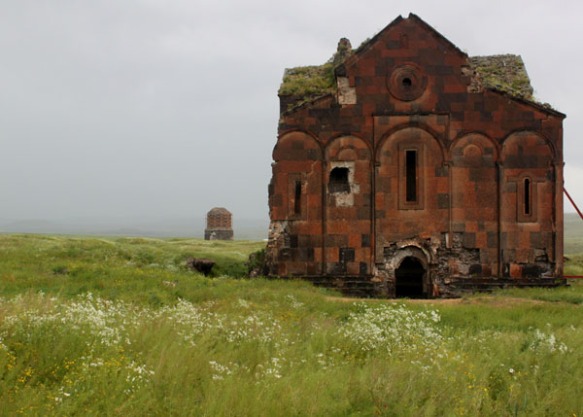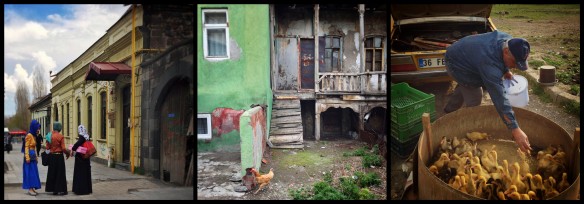Living in Kars is, in many ways, not so different from living in small towns anywhere. The language barrier exotifies things, sure, but in general, no truly radical culture clash happens. We even have a Burger King. Sure, it’s flanked by döner and baklava shops, but there it is, just like home! Sometimes, though, things happen that make you shake your head and go, “only in Kars”. Things in this category include: laundry hung out to dry on picturesque ruins, or the nearest mosque gate; the nearest mosque actually being an old Russian Orthodox church with minarets sticking out of it; or the occasional sheep or goose ambling through town, with or without its owner.
For example, today our yard was infested with cows. To clarify, errant farm animals have long stopped being newsworthy in Kars, but, aside from a few scrappy chickens, our yard is empty of wildlife. This morning, however, I glanced out the window over my morning coffee, and saw the two muddy behemoths strolling through the yard, methodically eating every green scrap in their path, and heading straight for our garden – and worse yet, for our cat, which was out on a leash on the clothesline (that may require a separate story; in short, the cat likes to escape and measures must be taken…). I bolted out of the house in my plaid pajama pants to shoo the cows away from our glorious zucchini bushes, and to rescue the cat, which has no sense, and continued lounging about in the grass, ignoring animals that could crush it with one hoof. Luckily, the cows were pliable and complacent and slowly, slowly, allowed themselves to be steered beyond the gate.
If the cowherds had known my feelings about cows, they would not have threatened with shooting us for allegedly plotting to steal them. We just wanted to see the Perseid meteor shower… ah, lying out on a blanket under the stars in the mild summer evening, with the smell of drying thistles and drying cow pats, while a searchlight waves over the hill, getting closer… wait, what? The two Turkish men found us, alright, and were not amused – I can see how we can be easily mistaken for cow-stealing masterminds, with our fleece blankets and tea thermos and our roomy 4×4. Thankfully, there were two ladies present, so they refrained from pulling their trigger on sight (as they told us in heated tones), and our suspicious “picnic” was broken up peacefully.
So, how to assuage the double disappointment of clouded-over skies and trigger-happy herders? Imagine you are sick of Turkish beer, and you are out of smuggled Georgian wine. Imagine you have gin, but the store-bought tonic is questionable, to put it mildly. What do you do? Luckily, if you are my resourceful coworker L., the answer isn’t “cry into your Efes” – the answer is, you buy a bag of bark and cook your own tonic water from scratch! And this is how, on a Saturday night, we came to be stirring a pot full of cinchona bark, allspice berries and citric acid crystals, brewing up a red-brown potion that puckers your face in on itself – until it is diluted with sufficient sugar and gin, giving a delicious and surprisingly close approximation of a gin&tonic. Heady on our success, our next project is planting coconut palms – coconut milk is impossible to find in Kars.


